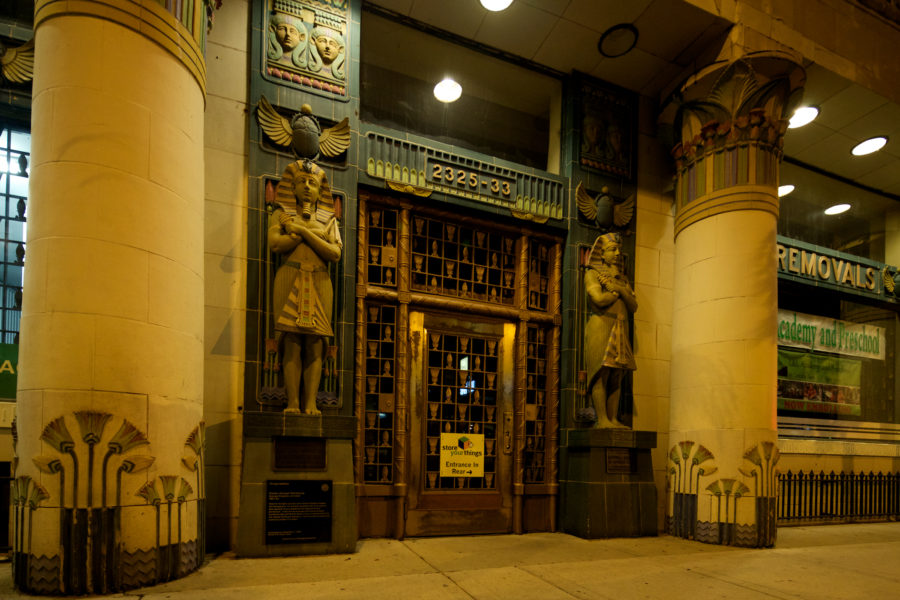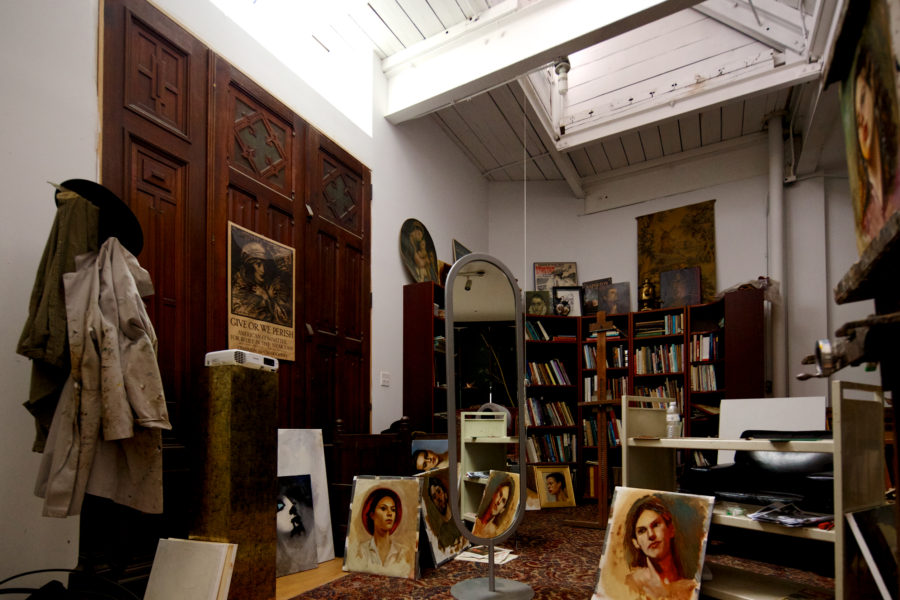The Portrait Artist and the Egyptian Lacquer Company

John Morris/Chicago Patterns
On a quiet street lined with utilitarian industrial buildings is an interesting part of the 1920s wave of Egyptomania that swept across the world after the discovery of the tomb of Tutankhamun.
Today, this architectural artifact is a studio for a portrait artist with no desire for publicity.
Egyptian-Inspired Architecture
There are several examples of Egyptian-influenced buildings in Chicago and across the world. Many of these buildings sprang up in the 1920s as more people became enthralled with the discovery of King Tut’s tomb, even though architecture in the Egyptian style predates that event.
It is often considered a variation of the Art Deco style of architecture.

Reebie Storage Warehouse at Clark/Fullerton. John Morris/Chicago Patterns
The Reebie Storage Warehouse (above) at Clark and Fullerton is usually lumped into the category of buildings inspired by the discovery of the tomb, but the design was commissioned prior to the tomb’s discovery.

A Permanent Tomb and Living Advertisement in the Egyptian Style
The building is located in East Garfield Park just south of Franklin Boulevard at 3025 W. Carroll Avenue.
Like the Reebie Storage Warehouse, it extended the metaphor beyond the exterior appearance–its construction almost resembles a fortress or tomb.
The Egyptian Lacquer Company (now known as Egyptian Coatings), traces its name to 1892:
The company adopted the “Egyptian” name in 1892, when archeological explorations in Egypt revealed ancient artifacts preserved with lacquer-like coatings.

Concrete walls and extra large steel support beams for a single story building. John Morris/Chicago Patterns
Because of the volatile and explosive nature of the business, the company was required to construct extra thick concrete walls and a much heavier steel frame than normally needed for a single-story building.
Construction completed in 1926.

The Chicago Sphinx, sculpted by Fritz Albert. John Morris/Chicago Patterns
Sculptor of the Chicago Sphinx: Fritz Albert
The realistic representation of the sphinx on the pediment of the Egyptian Lacquer Company Building was created by Fritz Albert, a sculptor who left his native Germany to sculpt for the 1893 World’s Columbian Exposition.
His early employment in Chicago was with the American Terra Cotta and Ceramic Company as its chief sculptor. In 1907, he was appointed as supervisor of the modeling department of the Northwestern Terra Cotta Company, the country’s largest manufacturer of ornamental terra cotta.
He also led the sculpture work for the Reebie Building, as well as the exterior cladding of the Wrigley Building.

Undated photo by Harold Allen courtesy of the School of the Art Institute
Harold Allen, Photographer and Historian of the Egyptian Style
The undated photo above (likely from the 1940s) was captured by noted historian and architecture photographer Harold Allen, also an instructor at the School of the Art Institute. He was captivated by Egyptian Art and architecture and traveled throughout the country to document it.

Harold Allen, courtesy of SAIC
A biography from SAIC provides insight on how Mr. Allen initially became interested in art and his determination to study it:
Inspired by Helen Gardner’s Art Through the Ages, which he found in the Blackfoot Public Library, Allen’s desire was to go to art school. After graduating from high school in 1930, he worked for seven years on hay and cattle ranches in Idaho and Wyoming to save money for school. He was intent on studying with Miss Gardner and becoming a painter. In 1937 at the age of 25 he enrolled in the School of the Art Institute of Chicago, where Miss Gardner taught classes in art history. Allen flourished at the School, eventually majoring in industrial design, but also studying photography.

Damaged terra cotta at the lower level of the entrance. John Morris/Chicago Patterns
Modern Egyptian Tomb Raiders
The current owner attributes the front entrance damage to the 1980s when thieves attempted to steal the sculpted terra cotta.
The warehouse across the street housed art students and they managed to chase away the thieves before ornament was lost, the owner said.

Hieroglyphs as marketing. John Morris/Chicago Patterns
Business Promotion in Hieroglyphs
Like the Reebie Storage Warehouse, the Egyptian Lacquer Company Building features hieroglyphs. Fritz Albert, the terra cotta sculptor who created the ornament for both buildings, is known for his attention to authenticity in recreating Egyptian hieroglyphs.
The exact translations of the inscriptions are unknown but are thought to represent the company and its products.

New Home as a Portrait Studio
The owner of the Egyptian Lacquer Company Building was kind enough to give me a tour of the interior and offer some history of the place.

Portraits by the artist who works in the Egyptian Lacquer Building. John Morris/Chicago Patterns
The owner is a portrait artist who works with oil paints.

Interior of Egyptian Lacquer Company Building. John Morris/Chicago Patterns
Though the owner may seem shy about getting recognition for his artistic pursuits, he’s no recluse when it comes to sharing his appreciation for the building. Open House Chicago has featured the Egyptian Lacquer Company a few years ago for the general public.
The space may once again open to the public. Until then, the cat (above) is one of the few who can wander freely throughout a notable structure of Chicago’s diverse architectural scene.
References and Further Reading
- Egyptian buildings in Chicago (Chicago Architecture Data)
- Harold Allen Photography Collection (SAIC)
- Reebie Storage Warehouse (City of Chicago)
Related Articles
- 500 North: A Look at Franklin Boulevard
- Garfield Park Fieldhouse, the “Gold Dome Building”
- 19th-Century Chicago Addresses on the West Side


The vandalism incident was mentioned in the book Unexpected Chicagoland (which has a few photos of this building on p.86) by Camilo Vergara and Tim Samuelson: “Once, at night, scavengers tried to remove the ornamentation, but neighborhood artists came out with baseball bats to defend the building.”
Great article. I’ve met the cat in the last photo–very friendly.
Noah,
Thank you for the kind words as well as the reminder of that book. I’ve heard great things about it more than once (perhaps from you) and it’s now at the top of my list of books to buy.
My great-grandfather purchased The Egyptian Lacquer Company in the early 20’s and my grandfather and he went around the country, apparently expanding. There were ELC buildings in New York and San Francisco. I believe the SF one was also in the Egyptian style and is now gone. I have photographs of the site before construction and also a drawing of the hieroglyphs. Would love to see the interior! As a child (1966)my family moved from the East Coast (where the company was headquartered) to Chicago. Perhaps because of a rift in the family, or because the expansion had not worked out, we were never aware of the building here until I stumbled upon it in an online search!
PH: do you know what the street address was for ELC in New York City? My grandfather worked there around 1930. Trying to find old photos of the NYC building.